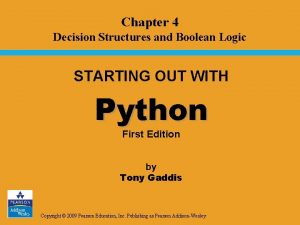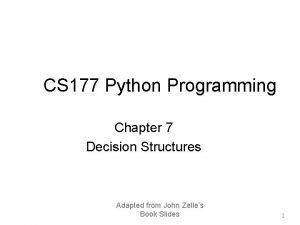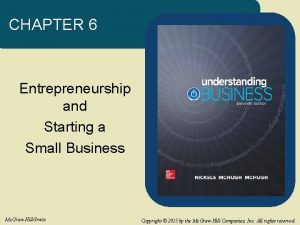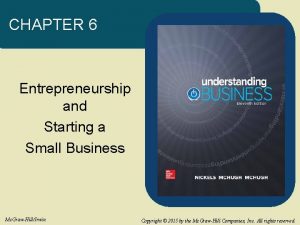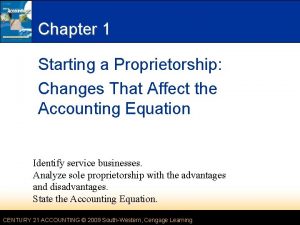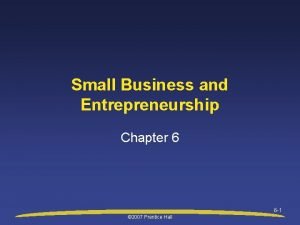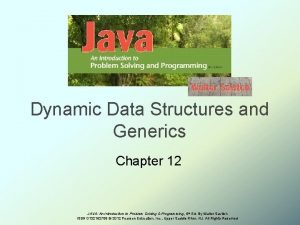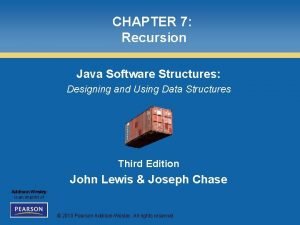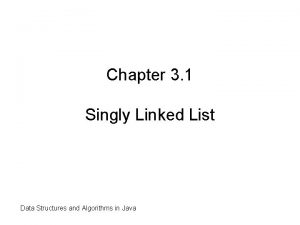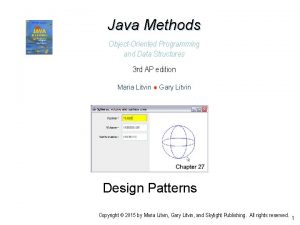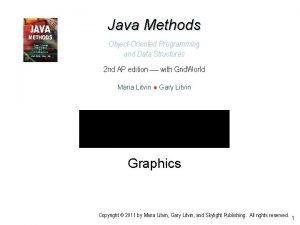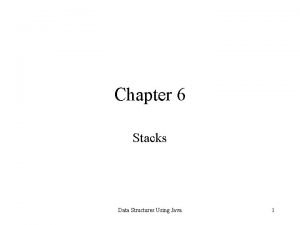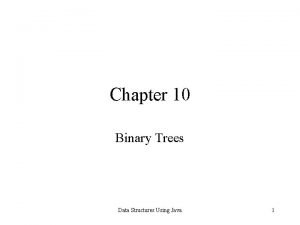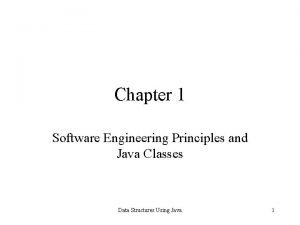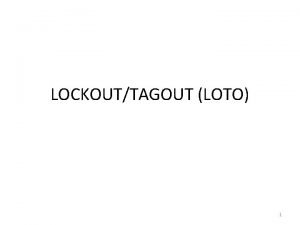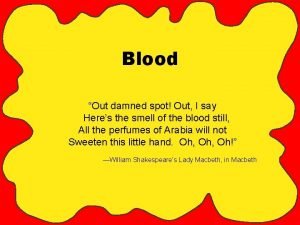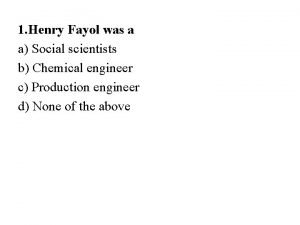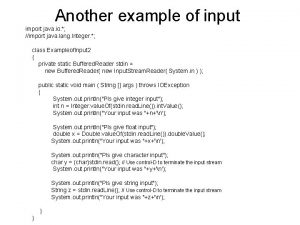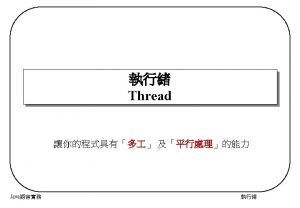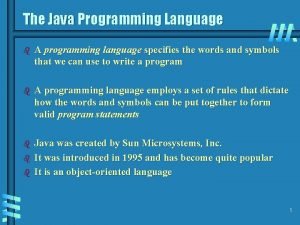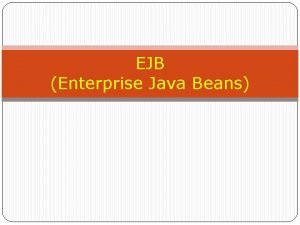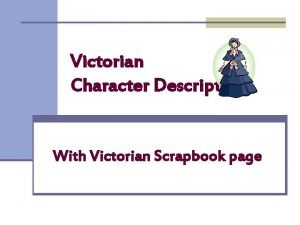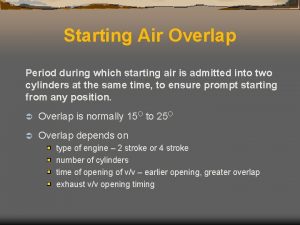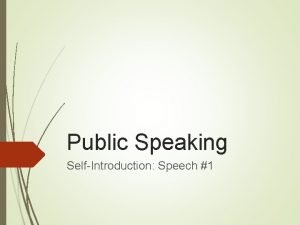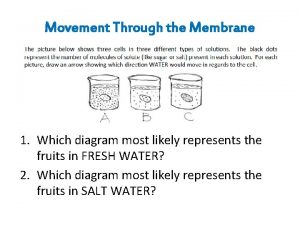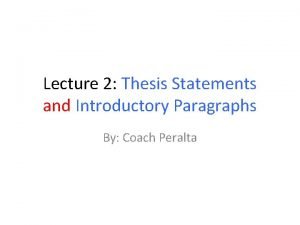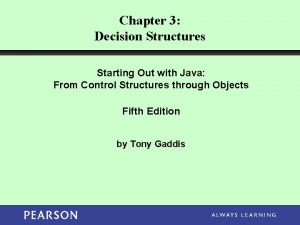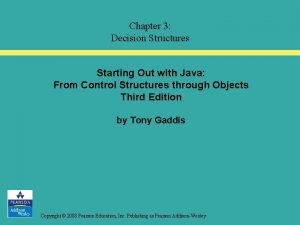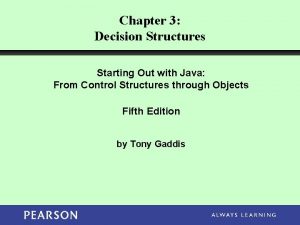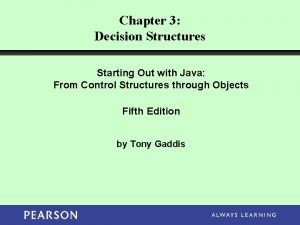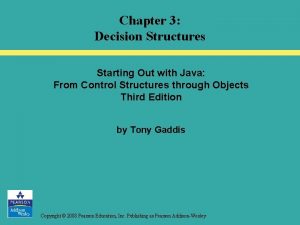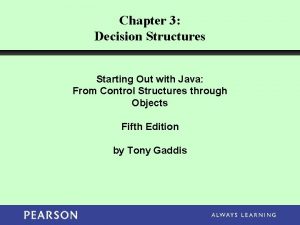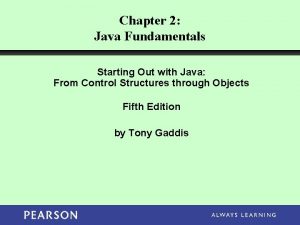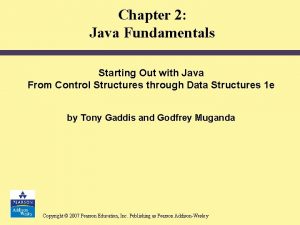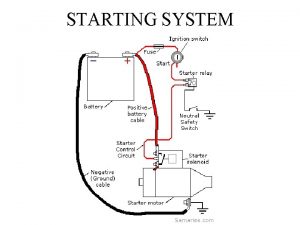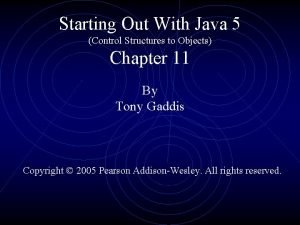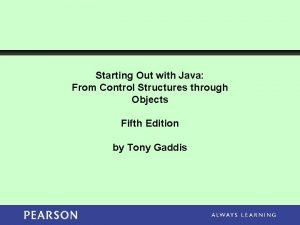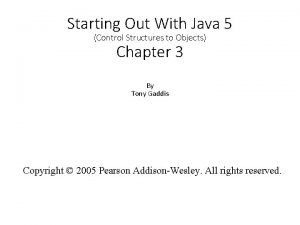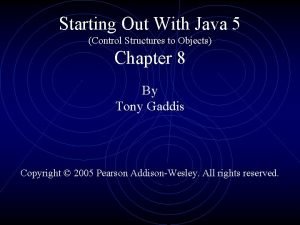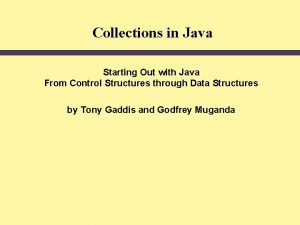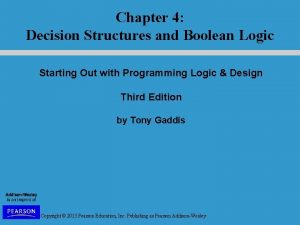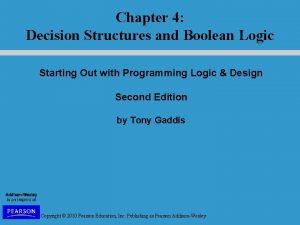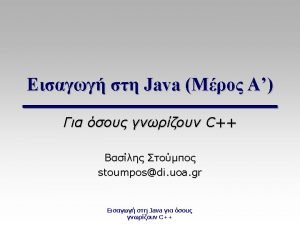Chapter 3 Decision Structures Starting Out with Java




























































- Slides: 60

Chapter 3: Decision Structures Starting Out with Java: From Control Structures through Objects Third Edition by Tony Gaddis Copyright © 2008 Pearson Education, Inc. Publishing as Pearson Addison-Wesley

Chapter Topics Chapter 3 discusses the following main topics: – The if Statement – The if-else-if Statement – Nested if Statements – Logical Operators – Comparing String Objects Copyright © 2008 Pearson Education, Inc. Publishing as Pearson Addison-Wesley 3 -2

Chapter Topics Chapter 3 discusses the following main topics: – More about Variable Declaration and Scope – The Conditional Operator – The switch Statement – The Decimal. Format Class – The Sales. Commission Class Copyright © 2008 Pearson Education, Inc. Publishing as Pearson Addison-Wesley 3 -3

The if Statement • The if statement decides whether a section of code executes or not. • The if statement uses a boolean to decide whether the next statement or block of statements executes. if (boolean expression is true) execute next statement. Copyright © 2008 Pearson Education, Inc. Publishing as Pearson Addison-Wesley 3 -4

Flowcharts • If statements can be modeled as a flow chart. if (cold. Outside) wear. Coat(); Is it cold outside? Yes Wear a coat. Copyright © 2008 Pearson Education, Inc. Publishing as Pearson Addison-Wesley 3 -5

Flowcharts • A block if statement may be modeled as: if (cold. Outside) { wear. Coat(); wear. Hat(); wear. Gloves(); } Is it cold outside? Yes Wear a coat. Wear a hat. Wear gloves. Note the use of curly braces to block several statements together. Copyright © 2008 Pearson Education, Inc. Publishing as Pearson Addison-Wesley 3 -6

Relational Operators • In most cases, the boolean expression, used by the if statement, uses relational operators. Relational Operator Meaning > is greater than < is less than >= is greater than or equal to <= is less than or equal to == is equal to != is not equal to Copyright © 2008 Pearson Education, Inc. Publishing as Pearson Addison-Wesley 3 -7

Boolean Expressions • A boolean expression is any variable or calculation that results in a true or false condition. Expression Meaning x > y Is x greater than y? x < y Is x less than y? x >= y Is x greater than or equal to y? x <= y Is x less than or equal to y. x == y Is x equal to y? x != y Is x not equal to y? Copyright © 2008 Pearson Education, Inc. Publishing as Pearson Addison-Wesley 3 -8

if Statements and Boolean Expressions if (x > y) System. out. println("X is greater than Y"); if(x == y) System. out. println("X is equal to Y"); if(x != y) { System. out. println("X is not equal to Y"); x = y; System. out. println("However, now it is. "); } Example: Average. Score. java Copyright © 2008 Pearson Education, Inc. Publishing as Pearson Addison-Wesley 3 -9

Programming Style and if Statements • An if statement can span more than one line; however, it is still one statement. if (average > 95) grade = ′A′; is functionally equivalent to if(average > 95) grade = ′A′; Copyright © 2008 Pearson Education, Inc. Publishing as Pearson Addison-Wesley 3 -10

Programming Style and if Statements • Rules of thumb: – The conditionally executed statement should be on the line after the if condition. – The conditionally executed statement should be indented one level from the if condition. – If an if statement does not have the block curly braces, it is ended by the first semicolon encountered after the if condition. if (expression) statement; No semicolon here. Semicolon ends statement here. Copyright © 2008 Pearson Education, Inc. Publishing as Pearson Addison-Wesley 3 -11

Block if Statements • Conditionally executed statements can be grouped into a block by using curly braces {} to enclose them. • If curly braces are used to group conditionally executed statements, the if statement is ended by the closing curly brace. if (expression) { statement 1; statement 2; Curly brace ends the statement. } Copyright © 2008 Pearson Education, Inc. Publishing as Pearson Addison-Wesley 3 -12

Block if Statements • Remember that when the curly braces are not used, then only the next statement after the if condition will be executed conditionally. if (expression) statement 1; statement 2; statement 3; Only this statement is conditionally executed. Copyright © 2008 Pearson Education, Inc. Publishing as Pearson Addison-Wesley 3 -13

Flags • A flag is a boolean variable that monitors some condition in a program. • When a condition is true, the flag is set to true. • The flag can be tested to see if the condition has changed. if (average > 95) high. Score = true; • Later, this condition can be tested: if (high. Score) System. out. println("That′s a high score!"); Copyright © 2008 Pearson Education, Inc. Publishing as Pearson Addison-Wesley 3 -14

Comparing Characters • Characters can be tested using the relational operators. • Characters are stored in the computer using the Unicode character format. • Unicode is stored as a sixteen (16) bit number. • Characters are ordinal, meaning they have an order in the Unicode character set. • Since characters are ordinal, they can be compared to each other. char c = ′A′; if(c < ′Z′) System. out. println("A is less than Z"); Copyright © 2008 Pearson Education, Inc. Publishing as Pearson Addison-Wesley 3 -15

if-else Statements • The if-else statement adds the ability to conditionally execute code when the if condition is false. if (expression) statement. Or. Block. If. True; else statement. Or. Block. If. False; • See example: Division. java Copyright © 2008 Pearson Education, Inc. Publishing as Pearson Addison-Wesley 3 -16

if-else Statement Flowcharts No Is it cold outside? Wear shorts. Copyright © 2008 Pearson Education, Inc. Publishing as Pearson Addison-Wesley Yes Wear a coat. 3 -17

if-else-if Statements • if-else-if statements can become very complex. • Imagine the following decision set. if it is very cold, wear a heavy coat, else, if it is chilly, wear a light jacket, else, if it is windy wear a windbreaker, else, if it is hot, wear no jacket. Copyright © 2008 Pearson Education, Inc. Publishing as Pearson Addison-Wesley 3 -18

if-else-if Statements if (expression) statement or block else if (expression) statement or block // Put as many else ifs as needed here else statement or block • Care must be used since else statements match up with the immediately preceding unmatched if statement. • See example: Test. Results. java Copyright © 2008 Pearson Education, Inc. Publishing as Pearson Addison-Wesley 3 -19

if-else-if Flowchart Copyright © 2008 Pearson Education, Inc. Publishing as Pearson Addison-Wesley 3 -20

Nested if Statements • If an if statement appears inside another if statement (single or block) it is called a nested if statement. • The nested if is executed only if the outer if statement results in a true condition. • See example: Loan. Qualifier. java Copyright © 2008 Pearson Education, Inc. Publishing as Pearson Addison-Wesley 3 -21

Nested if Statement Flowcharts No Yes Is it cold outside? Wear shorts. No Wear a jacket. Copyright © 2008 Pearson Education, Inc. Publishing as Pearson Addison-Wesley Is it snowing? Yes Wear a parka. 3 -22

if-else Matching • Curly brace use is not required if there is only one statement to be conditionally executed. • However, sometimes curly braces can help make the program more readable. • Additionally, proper indentation makes it much easier to match up else statements with their corresponding if statement. Copyright © 2008 Pearson Education, Inc. Publishing as Pearson Addison-Wesley 3 -23

if-else Matching This else matches with this if. if (employed == ′y′) { if (recent. Grad == ′y′) { System. out. println("You qualify for the " + "special interest rate. "); } else { System. out. println("You must be a recent " + "college graduate to qualify. "); } } else { System. out. println("You must be employed to qualify. "); } Copyright © 2008 Pearson Education, Inc. Publishing as Pearson Addison-Wesley 3 -24

Logical Operators • Java provides two binary logical operators (&& and ||) that are used to combine boolean expressions. • Java also provides one unary (!) logical operator to reverse the truth of a boolean expression. Copyright © 2008 Pearson Education, Inc. Publishing as Pearson Addison-Wesley 3 -25

Logical Operators Operator && || ! Meaning Effect AND Connects two boolean expressions into one. Both expressions must be true for the overall expression to be true. OR Connects two boolean expressions into one. One or both expressions must be true for the overall expression to be true. It is only necessary for one to be true, and it does not matter which one. NOT The ! operator reverses the truth of a boolean expression. If it is applied to an expression that is true, the operator returns false. If it is applied to an expression that is false, the operator returns true. Copyright © 2008 Pearson Education, Inc. Publishing as Pearson Addison-Wesley 3 -26

The && Operator • The logical AND operator (&&) takes two operands that must both be boolean expressions. • The resulting combined expression is true if (and only if) both operands are true. • See example: Logical. And. java Expression 1 Expression 2 Expression 1 && Expression 2 true false false true Copyright © 2008 Pearson Education, Inc. Publishing as Pearson Addison-Wesley 3 -27

The || Operator • The logical OR operator (||) takes two operands that must both be boolean expressions. • The resulting combined expression is false if (and only if) both operands are false. • Example: Logical. Or. java Expression 1 Expression 2 Expression 1 || Expression 2 true false false true Copyright © 2008 Pearson Education, Inc. Publishing as Pearson Addison-Wesley 3 -28

The ! Operator • The ! operator performs a logical NOT operation. • If an expression is true, !expression will be false. if (!(temperature > 100)) System. out. println("Below the maximum temperature. "); • If temperature > 100 evaluates to false, then the output statement will be run. Expression 1 !Expression 1 true false true Copyright © 2008 Pearson Education, Inc. Publishing as Pearson Addison-Wesley 3 -29

Short Circuiting • Logical AND and logical OR operations perform short-circuit evaluation of expressions. • Logical AND will evaluate to false as soon as it sees that one of its operands is a false expression. • Logical OR will evaluate to true as soon as it sees that one of its operands is a true expression. Copyright © 2008 Pearson Education, Inc. Publishing as Pearson Addison-Wesley 3 -30

Order of Precedence • The ! operator has a higher order of precedence than the && and || operators. • The && and || operators have a lower precedence than relational operators like < and >. • Parenthesis can be used to force the precedence to be changed. Copyright © 2008 Pearson Education, Inc. Publishing as Pearson Addison-Wesley 3 -31

Order of Precedence 1 Operators Description (unary negation) ! Unary negation, logical NOT 2 * / % 3 + - 4 < > <= >= 5 == != 6 && Logical AND 7 || Logical NOT 8 = += -= *= /= %= Multiplication, Division, Modulus Addition, Subtraction Less-than, Greater-than, Less-than or equal to, Greater-than or equal to Is equal to, Is not equal to Assignment and combined assignment operators. Copyright © 2008 Pearson Education, Inc. Publishing as Pearson Addison-Wesley 3 -32

Comparing String Objects • In most cases, you cannot use the relational operators to compare two String objects. • Reference variables contain the address of the object they represent. • Unless the references point to the same object, the relational operators will not return true. • See example: String. Compare. java • See example: String. Compare. To. java Copyright © 2008 Pearson Education, Inc. Publishing as Pearson Addison-Wesley 3 -33

Ignoring Case in String Comparisons • In the String class the equals and compare. To methods are case sensitive. • In order to compare two String objects that might have different case, use: – equals. Ignore. Case, or – compare. To. Ignore. Case • See example: Secret. Word. java Copyright © 2008 Pearson Education, Inc. Publishing as Pearson Addison-Wesley 3 -34

Variable Scope • In Java, a local variable does not have to be declared at the beginning of the method. • The scope of a local variable begins at the point it is declared and terminates at the end of the method. • When a program enters a section of code where a variable has scope, that variable has come into scope, which means the variable is visible to the program. • See example: Variable. Scope. java Copyright © 2008 Pearson Education, Inc. Publishing as Pearson Addison-Wesley 3 -35

The Conditional Operator • The conditional operator is a ternary (three operand) operator. • You can use the conditional operator to write a simple statement that works like an if-else statement. • The format of the operators is: expression 1 ? expression 2 : expression 3 • The conditional operator can also return a value. Copyright © 2008 Pearson Education, Inc. Publishing as Pearson Addison-Wesley 3 -36

The Conditional Operator • The conditional operator can be used as a shortened if-else statement: x > y ? z = 10 : z = 5; • This line is functionally equivalent to: if(x > y) z = 10; else z = 5; Copyright © 2008 Pearson Education, Inc. Publishing as Pearson Addison-Wesley 3 -37

The Conditional Operator • Many times the conditional operator is used to supply a value. number = x > y ? 10 : 5; • This is functionally equivalent to: if(x > y) number = 10; else number = 5; • See example: Consultant. Charges. java Copyright © 2008 Pearson Education, Inc. Publishing as Pearson Addison-Wesley 3 -38

The switch Statement • The if-else statement allows you to make true / false branches. • The switch statement allows you to use an ordinal value to determine how a program will branch. • The switch statement can evaluate an integer type or character type variable and make decisions based on the value. Copyright © 2008 Pearson Education, Inc. Publishing as Pearson Addison-Wesley 3 -39

The switch Statement • The switch statement takes the form: switch (Switch. Expression) { case Case. Expression: // place one or more statements here break; // case statements may be repeated //as many times as necessary default: // place one or more statements here } Copyright © 2008 Pearson Education, Inc. Publishing as Pearson Addison-Wesley 3 -40

The switch Statement • The switch statement takes an ordinal value (byte, short, int, long, or char) as the Switch. Expression. switch (Switch. Expression) { … } • The switch statement will evaluate the expression. • If there is an associated case statement that matches that value, program execution will be transferred to that case statement. Copyright © 2008 Pearson Education, Inc. Publishing as Pearson Addison-Wesley 3 -41

The switch Statement • Each case statement will have a corresponding Case. Expression that must be unique. case Case. Expression: // place one or more statements here break; • If the Switch. Expression matches the Case. Expression, the Java statements between the colon and the break statement will be executed. Copyright © 2008 Pearson Education, Inc. Publishing as Pearson Addison-Wesley 3 -42

The case Statement • The break statement ends the case statement. • The break statement is optional. • If a case does not contain a break, then program execution continues into the next case. – See example: No. Breaks. java – See example: Pet. Food. java • The default section is optional and will be executed if no Case. Expression matches the Switch. Expression. • See example: Switch. Demo. java Copyright © 2008 Pearson Education, Inc. Publishing as Pearson Addison-Wesley 3 -43

The Decimal. Format Class • When printing out double and float values, the full fractional value will be printed. • The Decimal. Format class can be used to format these values. • In order to use the Decimal. Format class, the following import statement must be used at the top of the program: import java. text. Decimal. Format; • See examples: Format 1. java, Format 2. java, Format 3. java, Format 4. java Copyright © 2008 Pearson Education, Inc. Publishing as Pearson Addison-Wesley 3 -44

The printf Method • You can use the System. out. printf method to performatted console output. • The general format of the method is: System. out. printf(Format. String, Arg. List); • Note: You can use the String. format() method to format strings in the same way as System. out. printf() and store the results in a String instead of printing them out to the console Copyright © 2008 Pearson Education, Inc. Publishing as Pearson Addison-Wesley 3 -45

The printf Method System. out. printf(Format. String, Arg. List); Format. String is a string that contains text and/or special formatting specifiers. Arg. List is optional. It is a list of additional arguments that will be formatted according to the format specifiers listed in the format string. Copyright © 2008 Pearson Education, Inc. Publishing as Pearson Addison-Wesley 3 -46

The printf Method • A simple example: System. out. printf("Hello Worldn"); Copyright © 2008 Pearson Education, Inc. Publishing as Pearson Addison-Wesley 3 -47

The printf Method • Another example: int hours = 40; System. out. printf("I worked %d hours. n", hours); Copyright © 2008 Pearson Education, Inc. Publishing as Pearson Addison-Wesley 3 -48

The printf Method int hours = 40; System. out. printf("I worked %d hours. n", hours); The %d format specifier indicates that a decimal integer will be printed. Copyright © 2008 Pearson Education, Inc. Publishing as Pearson Addison-Wesley The contents of the hours variable will be printed in the location of the %d format specifier. 3 -49

The printf Method • Another example: int dogs = 2, cats = 4; System. out. printf("We have %d dogs and %d cats. n", dogs, cats); Copyright © 2008 Pearson Education, Inc. Publishing as Pearson Addison-Wesley 3 -50

The printf Method • Another example: double gross. Pay = 874. 12; System. out. printf("Your pay is %f. n", gross. Pay); Copyright © 2008 Pearson Education, Inc. Publishing as Pearson Addison-Wesley 3 -51

The printf Method • Another example: double gross. Pay = 874. 12; System. out. printf("Your pay is %f. n", gross. Pay); The %f format specifier indicates that a floating-point value will be printed. The contents of the gross. Pay variable will be printed in the location of the %f format specifier. Copyright © 2008 Pearson Education, Inc. Publishing as Pearson Addison-Wesley 3 -52

The printf Method • Another example: double gross. Pay = 874. 12; System. out. printf("Your pay is %. 2 f. n", gross. Pay); Copyright © 2008 Pearson Education, Inc. Publishing as Pearson Addison-Wesley 3 -53

The printf Method • Another example: double gross. Pay = 874. 12; System. out. printf("Your pay is %. 2 f. n", gross. Pay); The %. 2 f format specifier indicates that a floating-point value will be printed, rounded to two decimal places. Copyright © 2008 Pearson Education, Inc. Publishing as Pearson Addison-Wesley 3 -54

The printf Method • Another example: String name = "Ringo"; System. out. printf("Your name is %s. n", name); The %s format specifier indicates that a string will be printed. Copyright © 2008 Pearson Education, Inc. Publishing as Pearson Addison-Wesley 3 -55

The printf Method • Specifying a field width: int number = 9; System. out. printf("The value is %6 dn", number); The %6 d format specifier indicates the integer will appear in a field that is 6 spaces wide. Copyright © 2008 Pearson Education, Inc. Publishing as Pearson Addison-Wesley 3 -56

The printf Method • Another example: double number = 9. 76891; System. out. printf("The value is %6. 2 fn", number); The %6. 2 f format specifier indicates the number will appear in a field that is 6 spaces wide, and be rounded to 2 decimal places. Copyright © 2008 Pearson Education, Inc. Publishing as Pearson Addison-Wesley 3 -57

Format Specifiers • The format specifiers for general, character, and numeric types have the following syntax: %[argument_index$][flags][width][. precision]conversion • The optional argument_index is a decimal integer indicating the position of the argument in the argument list. The first argument is referenced by "1$", the second by "2$", etc. • The optional flags is a set of characters that modify the output format. The set of valid flags depends on the conversion. • The optional width is a non-negative decimal integer indicating the minimum number of characters to be written to the output. • The optional precision is a non-negative decimal integer usually used to restrict the number of characters. The specific behavior depends on the conversion. • The required conversion is a character indicating how the argument should be formatted. The set of valid conversions for a given argument depends on the argument's data type. Copyright © 2008 Pearson Education, Inc. Publishing as Pearson Addison-Wesley 3 -58

Format String Conversion Specifiers Conversion 'b', 'B' 'h', 'H' 's', 'S' 'c', 'C' 'd' 'o' 'x', 'X' 'e', 'E' 'f' 'g', 'G' 'a', 'A' 't', 'T' '%' 'n' Description Boolean Hexadecimal integer String Character Integer Octal integer Hexadecimal integer Scientific notation Floating-point (real) number Scientific notation Hexadecimal floating-point number Date/Time The result is a literal '%' ('u 0025') The result is the platform-specific line separator Copyright © 2008 Pearson Education, Inc. Publishing as Pearson Addison-Wesley 3 -59

Format Specifier Flags Flag Gen String Int Float Date Description '-' y y y '#' y 1 - y 3 y - '+' - - y 4 y - '0' - - y y - ', ' - - y 2 y 5 - '(' - - y 4 y 5 - The result will be left-justified. The result should use a conversion-dependent alternate form The result will always include a sign The result will include a leading space for positive values The result will be zero-padded The result will include locale-specific grouping separators The result will enclose negative numbers in parentheses 1 Depends on the definition of Formattable. 2 For 'd' conversion only. 3 For 'o', 'x', and 'X' conversions only. 4 For 'd', 'o', 'x', and 'X' conversions applied to Big. Integer or 'd' applied to byte, Byte, short, Short, int and Integer, long, and Long. 5 For 'e', 'E', 'f', 'g', and 'G' conversions only. Copyright © 2008 Pearson Education, Inc. Publishing as Pearson Addison-Wesley 3 -60
 No decision snap decision responsible decision
No decision snap decision responsible decision Dividend decision in financial management
Dividend decision in financial management Songs with poetic devices
Songs with poetic devices Analogous structure
Analogous structure Nested decision structures in python
Nested decision structures in python Decision structures in python
Decision structures in python Chapter 30 engine starting systems
Chapter 30 engine starting systems Chapter 4 performing basic maneuvers worksheet answers
Chapter 4 performing basic maneuvers worksheet answers Chapter 6 entrepreneurship and starting a small business
Chapter 6 entrepreneurship and starting a small business Chapter 6 entrepreneurship and starting a small business
Chapter 6 entrepreneurship and starting a small business Chapter 6 entrepreneurship and small business management
Chapter 6 entrepreneurship and small business management Chapter 1 starting a proprietorship
Chapter 1 starting a proprietorship Entrepreneurship and small business management chapter 6
Entrepreneurship and small business management chapter 6 Decision table and decision tree examples
Decision table and decision tree examples Advanced data structures in java
Advanced data structures in java Java dynamic data structures
Java dynamic data structures Data structures and abstractions with java
Data structures and abstractions with java Java software structures 4th edition
Java software structures 4th edition Singly linked list in data structure
Singly linked list in data structure Data structures in java
Data structures in java Data structures in java
Data structures in java Data structures using java
Data structures using java Data structures using java
Data structures using java Data structures using java
Data structures using java Put out the light then put out the light
Put out the light then put out the light Robert frost poems
Robert frost poems Outta sight outta mind quotes
Outta sight outta mind quotes Mending wall annotations
Mending wall annotations Lock out tag out safety talk
Lock out tag out safety talk Personification in the road not taken
Personification in the road not taken Lily gulledge
Lily gulledge Matthew 11:28 message
Matthew 11:28 message Lock ouy
Lock ouy Out, damned spot! out, i say!
Out, damned spot! out, i say! Henri fayol was a social scientist
Henri fayol was a social scientist Makna out of sight out of mind
Makna out of sight out of mind Log out tag out deutsch
Log out tag out deutsch Import java.util.scanner;
Import java.util.scanner; Import java.util.*
Import java.util.* Import java.awt.*
Import java.awt.* Import util scanner
Import util scanner Import java.io.*
Import java.io.* Import java.util.scanner;
Import java.util.scanner; Str2str 使い方
Str2str 使い方 Java import java.io.*
Java import java.io.* Java import java.util.*
Java import java.util.* Java thread import
Java thread import Perbedaan java swing dan awt
Perbedaan java swing dan awt Import java.awt.event.*;
Import java.awt.event.*; Language
Language Rmi javatpoint
Rmi javatpoint Thinking of starting a business
Thinking of starting a business Character traits starting with n
Character traits starting with n Qualities starting with n
Qualities starting with n Pony motor starting method
Pony motor starting method Overlap in starting air system
Overlap in starting air system Presentation starting speech
Presentation starting speech Kamasutra standing positions
Kamasutra standing positions Photosynthesis recipe card
Photosynthesis recipe card Thesis statement starting words
Thesis statement starting words How to start introduction
How to start introduction




